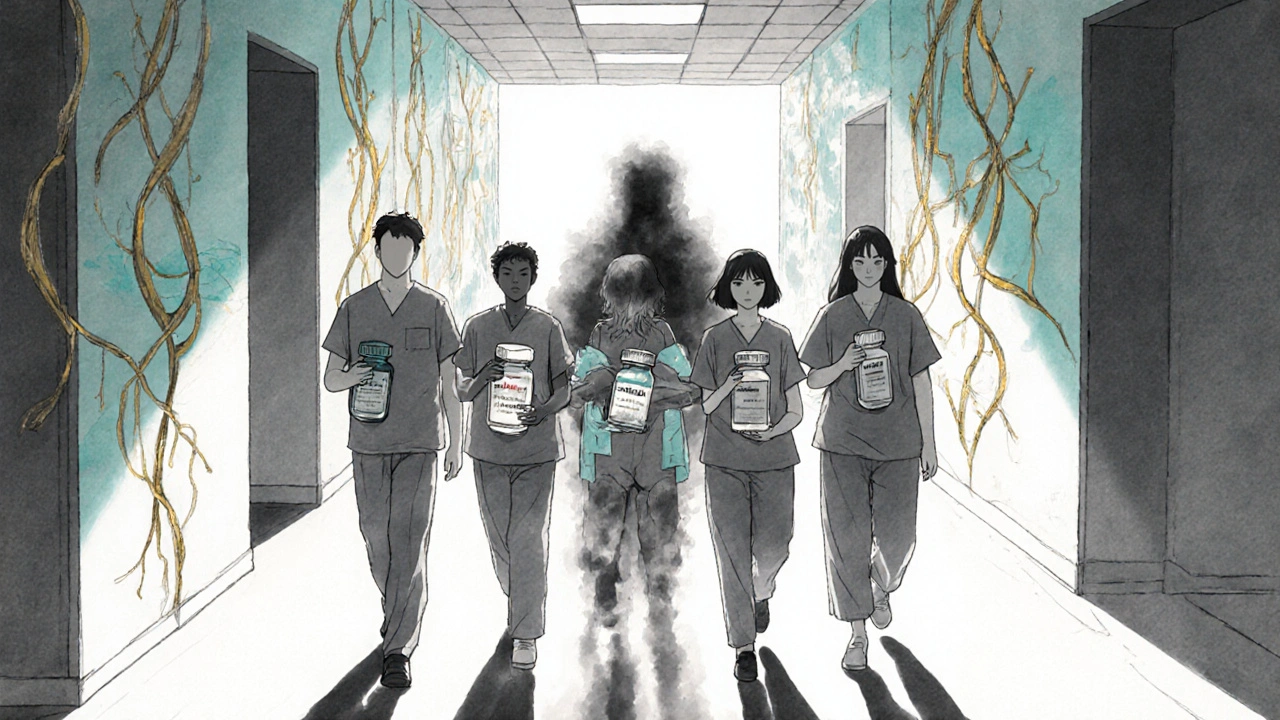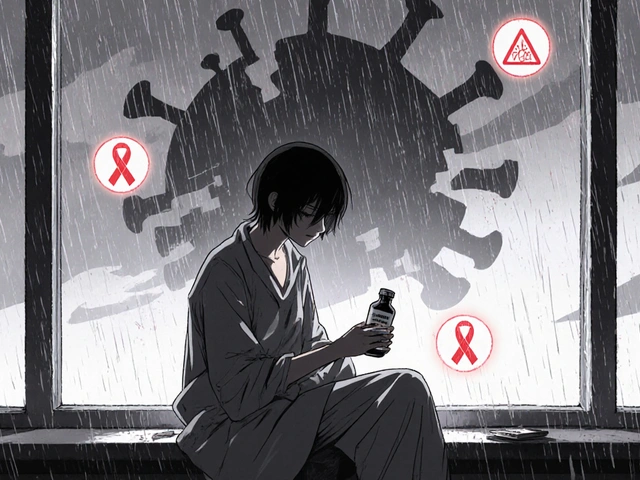Compare Viramune (Nevirapine) with Other HIV Medications

HIV Medication Suitability Calculator
Find Your Best HIV Medication Option
Answer a few questions to see which HIV medications might be best for your situation based on the latest medical guidelines.
Recommended Options
Top Matched Medications
Based on your profileWhy These Options?
Viramune (nevirapine) was one of the first non-nucleoside reverse transcriptase inhibitors (NNRTIs) approved for treating HIV. It helped turn HIV from a death sentence into a manageable condition in the 1990s. But today, it’s rarely the first choice. Why? Because newer drugs are safer, simpler, and more effective. If you’re on Viramune or considering it, you deserve to know what else is out there-and what might work better for you.
How Viramune Works
Viramune blocks HIV from copying its genetic material inside your cells. It does this by attaching to an enzyme called reverse transcriptase. Without it, the virus can’t make new copies of itself. That’s the core idea behind most HIV drugs: stop the virus from multiplying.
But Viramune has a big problem: it’s unpredictable in the body. Some people clear it fast, others slowly. That means the drug level in your blood can swing too low (letting the virus survive) or too high (causing side effects). This is why doctors used to need to start patients on a low dose for two weeks before increasing it. That’s not just inconvenient-it’s risky.
Common Side Effects of Viramune
Up to 20% of people taking Viramune develop a rash. Most are mild, but about 1 in 100 get a serious skin reaction that can lead to liver failure or even death. The risk is highest in the first 6 weeks, especially in women with higher CD4 counts at the start of treatment.
Liver damage is another real concern. Symptoms include yellow skin, dark urine, nausea, or pain under the right ribs. If you’re on Viramune, you need regular blood tests for at least the first 18 weeks. Many patients drop it because of these risks, not because it doesn’t work.
Why Viramune Is No Longer First-Line
In 2019, the World Health Organization stopped recommending Viramune as a first-choice drug for adults and adolescents. The U.S. Department of Health and Human Services says the same. Why? Because better options exist.
Modern HIV regimens use drugs that:
- Require just one pill a day
- Have fewer side effects
- Don’t need dose titration
- Have higher barriers to resistance
Viramune doesn’t meet those standards anymore. It’s still used in some low-income countries because it’s cheap. But if you have access to modern care, there’s almost always a safer alternative.

Top Alternatives to Viramune
Here are the most common NNRTIs and other drug classes that have replaced Viramune in most treatment plans.
1. Efavirenz (Sustiva)
For years, efavirenz was the go-to alternative to Viramune. It’s more potent, doesn’t need a lead-in dose, and has a longer half-life. But it has its own issues: nightmares, dizziness, and mood changes in up to 50% of users. Many stop it within the first few months.
It’s still used in some parts of the world, but even efavirenz is being phased out now.
2. Rilpivirine (Edurant)
Rilpivirine is a newer NNRTI with fewer side effects than either Viramune or efavirenz. It’s taken once daily and doesn’t cause liver toxicity or serious rashes. But it has one big catch: it needs food to be absorbed. If you skip meals, your drug level drops, and the virus can become resistant.
It’s a good option for people who eat regularly and don’t have high viral loads at the start of treatment.
3. Doravirine (Pifeltro)
Doravirine is the newest NNRTI on the market. It’s designed to be safer than its predecessors. Clinical trials show it causes fewer dizziness, sleep problems, and liver issues than efavirenz. It also works well even if you’ve had prior NNRTI exposure.
It’s taken once daily, with or without food. No dose titration. No black box warning for liver failure. It’s become a popular choice for people switching from older drugs.
4. Dolutegravir (Tivicay)
Dolutegravir isn’t an NNRTI-it’s an integrase inhibitor. That means it blocks HIV at a different step in its life cycle. And it’s now the most recommended first-line drug globally.
It’s powerful, taken once daily, and has a high barrier to resistance. Even if you miss a dose, it still works. Side effects are mild: occasional headaches or trouble sleeping. It’s also safe during pregnancy, unlike Viramune.
One rare concern: a small increased risk of neural tube defects if taken at conception. But that risk is lower than previously thought, and it’s still considered safe for most women.
5. Bictegravir (in Biktarvy)
Bictegravir is another integrase inhibitor, usually combined with two other drugs in a single pill called Biktarvy. It’s one of the most prescribed HIV regimens today in the U.S. and Europe.
It’s simple: one pill, once a day. No food restrictions. No lab monitoring beyond routine checks. No serious rashes or liver warnings. And it works even if you’ve tried other drugs before.
Many patients who switch from Viramune to Biktarvy report feeling better within weeks-less fatigue, better sleep, no skin issues.
Comparison Table: Viramune vs Key Alternatives
| Drug | Class | Dosing | Food Required? | Common Side Effects | Black Box Warning? | Resistance Barrier |
|---|---|---|---|---|---|---|
| Viramune (Nevirapine) | NNRTI | Start low, then increase | No | Rash, liver damage, fatigue | Yes (liver failure, skin reactions) | Low |
| Efavirenz | NNRTI | Once daily | No | Dizziness, nightmares, mood changes | No | Low |
| Rilpivirine | NNRTI | Once daily | Yes (with meal) | Headache, insomnia, mild rash | No | Low |
| Doravirine | NNRTI | Once daily | No | Mild headache, nausea | No | High |
| Dolutegravir | Integrase inhibitor | Once daily | No | Headache, insomnia | No | Very high |
| Bictegravir (Biktarvy) | Integrase inhibitor | Once daily (single pill) | No | Mild diarrhea, nausea | No | Very high |
Who Should Still Consider Viramune?
There are only a few cases where Viramune might still make sense:
- People in low-income countries where newer drugs aren’t available or are too expensive
- Those who’ve tried every other option and still respond well to it
- Patients with specific allergies or intolerances to other drugs
If you’re on Viramune and doing fine-no side effects, undetectable viral load, normal liver tests-you might not need to switch. But if you’ve had a rash, liver issues, or just feel off, talk to your doctor about upgrading.

What to Do If You’re on Viramune
Here’s what to ask your provider:
- Have I had any liver enzyme spikes or skin reactions?
- Is my viral load still undetectable after more than a year?
- Are there newer drugs I could switch to that require fewer blood tests?
- Would a single-pill regimen improve my daily routine?
If you’ve been on Viramune for more than 2 years, you’re in the low-risk window for serious side effects. But that doesn’t mean you’re safe from long-term issues. Newer drugs have better safety profiles over decades of use.
Real-Life Switch Stories
One woman in her 40s switched from Viramune to Biktarvy after developing a persistent rash. Within two weeks, her skin cleared. Her energy came back. She stopped needing monthly liver tests.
A man in his 50s switched to dolutegravir after having nightmares from efavirenz. He says he’s slept through the night for the first time in 10 years.
These aren’t rare cases. They’re becoming the norm.
Final Thoughts
Viramune saved lives. But medicine doesn’t stand still. Today’s HIV treatment is simpler, safer, and more forgiving. You don’t have to live with daily worries about rashes or liver damage if you don’t have to.
If you’re on Viramune, don’t panic. But do ask: Is this still the best option for me? There’s a good chance it’s not. And switching could mean more energy, fewer doctor visits, and a better quality of life.
Is Viramune still used today?
Yes, but only in specific situations. It’s still used in some low-income countries due to cost. In high-income countries, it’s rarely prescribed as a first-line treatment. Most patients on Viramune today are long-term users who’ve never had side effects and have stable viral loads.
Can Viramune cause liver damage?
Yes. Up to 1% of people taking Viramune develop severe liver injury, sometimes fatal. This risk is highest in the first 18 weeks, especially in women with CD4 counts above 250. Regular liver function tests are required during the first few months of treatment.
What’s the safest HIV medication today?
Dolutegravir and bictegravir (in Biktarvy) are considered among the safest and most effective. They have high barriers to resistance, minimal side effects, no food restrictions, and no black box warnings. They’re recommended as first-line options by WHO and U.S. health guidelines.
Can I switch from Viramune to a newer drug?
Yes, most people can switch safely. Your doctor will check your viral load, resistance history, and kidney/liver function before switching. Many switch to single-pill regimens like Biktarvy or Dovato. Side effects from the new drug usually appear within the first 2-4 weeks.
Why is Viramune being phased out?
Because newer drugs are safer, simpler, and more effective. Viramune requires careful dosing, carries serious risks like liver failure and skin reactions, and has a low barrier to resistance. Modern drugs work better with fewer side effects and no need for frequent monitoring.



Mary Follero
Just wanted to say how refreshing it is to see a clear, honest breakdown of HIV meds without the usual corporate fluff. I work in public health and see so many patients stuck on outdated regimens because their providers don’t keep up. Viramune’s risks are real, but the bigger issue is access. In rural clinics, they still use it not because it’s ideal, but because it’s the only thing they can afford. We need systems that bridge that gap, not just clinical debates.
Switching to dolutegravir or Biktarvy isn’t just about safety-it’s about dignity. No more weekly liver panels. No more panic when a rash appears. One pill, once a day, and you can actually live your life. That’s not medicine-that’s liberation.
prasad gali
The pharmacokinetic variability of nevirapine is a classic example of poor drug design in the pre-PK/PD era. The CYP3A4/2B6 polymorphism-driven clearance leads to subtherapeutic exposure in rapid metabolizers and hepatotoxicity in slow metabolizers. Modern INSTIs like dolutegravir exhibit linear pharmacokinetics with minimal interindividual variability, making them far superior from a therapeutic drug monitoring standpoint. The black box warning on nevirapine remains a relic of inadequate pre-marketing pharmacovigilance.
Tara Stelluti
I knew a girl who went blind from Viramune. Not a joke. Not exaggeration. She woke up one morning and couldn’t see. Doctors said it was a rare autoimmune reaction triggered by the drug. They told her to ‘be grateful she didn’t die.’
Now she’s on Biktarvy. Sees again. Works. Lives. But she’ll never trust Big Pharma the same way. And neither will I.
Will Phillips
They say Viramune is outdated but they never tell you the real reason they pulled it-pharma wants you on the expensive combo pills that make them billions. Dolutegravir? 1200 bucks a month. Viramune? 12 bucks. Who’s really protecting you here? The doctors? Or the shareholders?
They want you to think it’s about safety but it’s about profit. Always is. You think they’d let you switch if it didn’t increase their revenue? Think again. They’re not saving lives-they’re selling subscriptions.
Hannah Machiorlete
i swear if one more person tells me to "just switch to biktarvy" i will scream. i’ve been on viramune for 15 years. my viral load is undetectable. my liver is fine. my skin is fine. why does everyone act like i’m a walking time bomb? i’m not a statistic. i’m not a case study. i’m just a person who got lucky.
stop gaslighting me into changing because your google search says so.
Paige Basford
Actually, I’ve been on Viramune since 2010 and I’ve had zero issues. I know people who switched and got weird side effects from the new drugs-like dolutegravir giving them insomnia for months. Maybe it’s not one-size-fits-all?
I mean, I get that newer is trendier, but if it ain’t broke…? I’m not gonna risk something new just because a doctor says so. I’ve got my routine. My pills. My peace of mind. Why mess with it?
Danielle Mazur
Let’s not pretend this is about medical progress. This is about control. The CDC, WHO, and pharmaceutical giants have a coordinated campaign to phase out generics like Viramune to push branded single-pill regimens. Why? Because once you’re on Biktarvy, you’re locked in. No generics. No cost savings. No escape.
They call it "improvement." I call it corporate consolidation. They don’t want you to know you can survive on $12/month. They want you dependent on $1200/month. And they’ve bought every medical school, every guideline, every doctor’s loyalty to make sure you never question it.
Abdula'aziz Muhammad Nasir
As a clinician in Lagos, I can confirm Viramune is still the backbone of our first-line ART program. We don’t have access to doravirine or Biktarvy. But we have trained nurses, regular monitoring, and community adherence support. The death rates from rash or liver toxicity are low when you follow protocols.
Yes, newer drugs are better. But dismissing Viramune entirely ignores the reality of global health equity. We don’t need to replace it-we need to fund it better. Better labs. Better education. Better follow-up. Not just swap it for something unaffordable.
Ankita Sinha
Can we talk about how weird it is that we still use the word "phased out" like it’s some kind of progress? Like Viramune was a bad old thing we grew out of. But it saved my mom’s life in 2001. She didn’t have a choice back then. She didn’t get to pick between one pill and two.
I’m grateful for the newer drugs, I really am. But let’s not erase the people who made this possible. Viramune wasn’t the enemy. The system that made it the only option was.
Jeff Moeller
Medicine is a mirror. We don’t just treat viruses-we treat our fears. Viramune scared us because it was unpredictable. So we replaced it with drugs that feel safer, even if they’re just different kinds of risk.
But here’s the truth: no pill is perfect. No regimen is foolproof. The real breakthrough isn’t the drug-it’s the shift from survival to living. From fear to routine. From panic to peace.
Maybe the question isn’t which drug is best.
It’s whether we’ve learned to trust ourselves enough to choose.
Kenneth Meyer
It’s funny how we treat HIV meds like they’re all the same. Like switching from Viramune to Biktarvy is just swapping one soda for another.
But for people living with this, it’s not about efficacy. It’s about identity. It’s about the daily ritual. The fear of side effects. The shame of being "different." The relief of being invisible.
The real revolution isn’t the pill. It’s the quiet dignity of being able to take your medicine without explaining it to anyone.
That’s what we’re really fighting for.
Bette Rivas
It’s important to clarify that while Viramune is no longer recommended as first-line therapy in high-resource settings, its discontinuation does not imply clinical failure in all cases. The WHO’s 2019 guidelines explicitly state that patients currently stable on Viramune with undetectable viral load, normal transaminases, and no history of hypersensitivity should not be routinely switched.
Additionally, the risk of nevirapine-induced hepatotoxicity decreases significantly after 18 weeks of therapy, and long-term users (>2 years) demonstrate a safety profile comparable to modern agents in observational cohorts. The decision to switch must be individualized, not protocol-driven. Overzealous deprescribing can introduce new risks, including virologic rebound during transition and psychosocial disruption.
Patients deserve autonomy, not algorithmic mandates.
Donald Sanchez
ok so i switched from viramune to biktarvy last year and like?? i dont even remember the last time i had a headache?? like my skin cleared up and i actually sleep now?? like i used to be so tired all the time and now i run marathons?? idk man i just feel human again?? 💪✨
also my dr said i dont need blood tests every month anymore?? like what even is this magic??